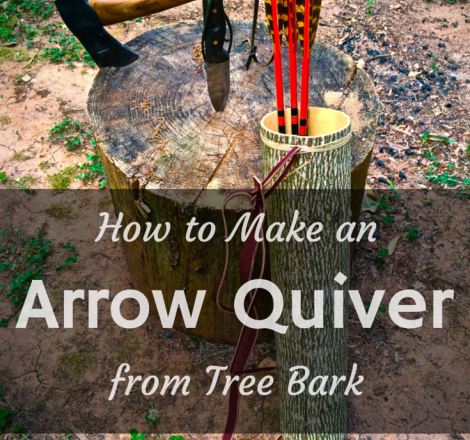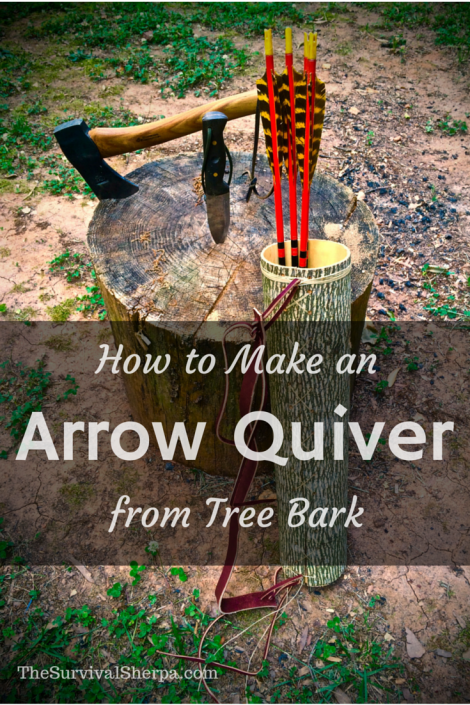
The Tulip Poplar is the Swiss Army Knife of woodcraft and self-reliance. The properties of this Eastern Woodlands tree lends itself to many self-reliant uses…
- Primitive fire – bow drill sets and tinder material
- Inner bark for natural cordage
- Spoons, bowls, cups, and tools
- Medicinal uses
- Material and building uses which we employ today
The best time to harvest the bark is late spring and early summer when the sap is rising.
Obviously, you don’t want to cut down the only tulip tree in the forest. I scout my woods to find an overcrowded stand of poplars and harvest one out of 3 or 4 which are close together. The rest of the tree doesn’t go to waste. What’s not used for containers is used for natural cordage, tinder material, spoons and bowls, and primitive fire sets.
Trees under 6 inches in diameter are felled with my take down buck saw. I use an ax for trees over 6 inches. Need felled a tree? Click here to learn how.
Arrow Quiver
The entire process can be done in the woods. Or, do as I did… cut the log into 6 foot lengths and haul it to the vehicle for transport home. Actually, I did part of the project in the woods and finished up at my shop.
Below are a few tools used to make my quiver…
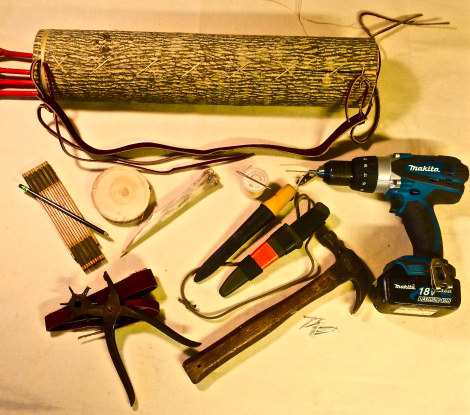
Cut and Remove Bark
On a straight section with few knots (or eyes), measure off the desire length of your quiver. Cut through the bark to the white sap wood on both ends in a ring fashion. A saw makes quick work of this task but can also be done with a knife.
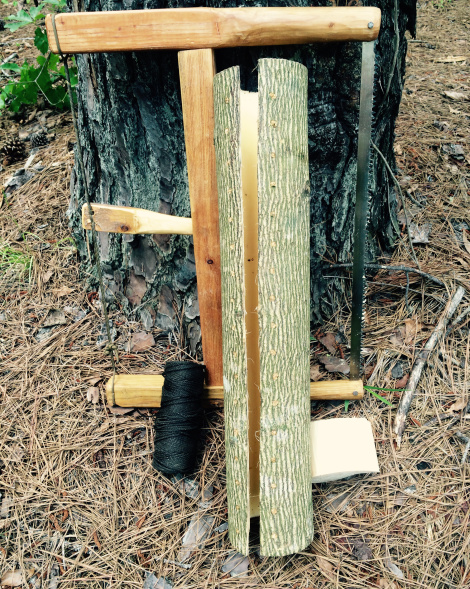
With your knife, cut a straight line from both ring cuts down the length of the log all the way to the sap wood. Be sure to cut through the outer and inner bark.
Related:Tips for Bow Hunting for Survival
Work your knife or a wedged stick under one edge where the parallel cut meets the ring cut and begin gently prying the bark free from the sap wood.
Take it easy. Going too fast will cause the bark to crack and ruin your resource. You’re not cutting the bark loose as you might skin a big game animal. The knife is a pry bar now. Free the bark about an inch or so on both edges of the center cut.
Wedge your fingers between the freed bark edge and the sap wood and slowly begin separating the bark. Work your way around the entire log from the center cut. Be careful not to prick your finger on any small prickly points on the sap wood.
Once disconnected from the sap wood, the flexible bark sleeve can be removed. Now your ready to make lacing holes along both sides of the center cut.
Bore Holes
Now that the bark is off the tree, slip it back on. The log will be used as an anvil for boring lacing holes along both sides of the center cut. You don’t have to use the log as an anvil but it’s a bit more convenient to do so. A wheel punch used in leather work is another option for making holes in bark.
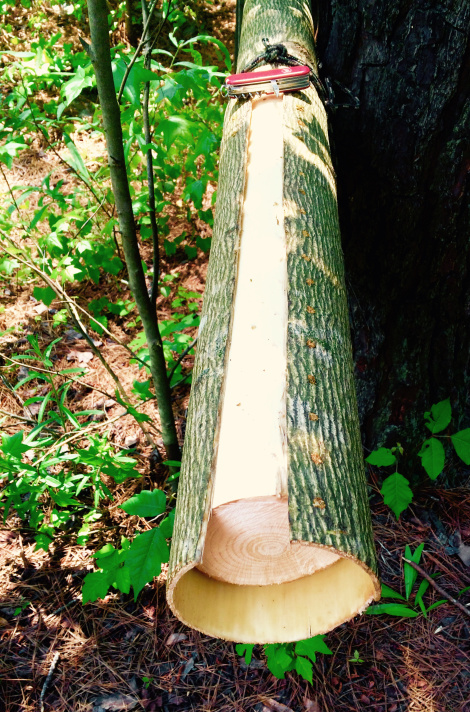
With a bone awl or modern awl, bore a line of holes about 1/2 inch from the edge of both center cuts. I spaced my row of holes about 1.5 inches apart – starting at about 1 inch from each end. Try to keep the holes matched up on both sides of the center cut.
Lacing
Rawhide, natural cordage, or synthetic string are all options. Your choice depends on what’s available and how primitive you want your quiver to look. Tarred bank line is a down and dirty option that will work… forever.
I used artificial sinew and leather work needles to stitch the seam in a ‘X’ pattern. Measure and use about 4 times the length of the quiver in cordage. This allows enough leftover cordage to attach a carrying sling when the stitching is done.
Plug End
Cut a 1/2 to 3/4 inch section of wood off the log to be used as a plug for the quiver. The plug cut should come from where you made your ring cut.
Once the seam is laced (loosely), insert the plug into the end of your quiver. Tighten the lacing. Stand the quiver vertically and tap the plug end on a flat surface to ensure a flush fit. The lacing will hold the plug via friction but needs a more secure method.
I used about 8 small nails spaced around the plug end. Drill evenly spaced pilot holes which are slightly smaller than the diameter of your nails/tacks. Hammer the nails into the pilot holes to secure.
As the bark dries, it curls in on itself. The plug prevents this on the bottom end. However, on the open end, stuff some newspaper, bubble wrap, or other material a few inches down tube to hold the cylindrical shape as it dries. The drying time takes a few days to a week depending on weather conditions.
Related:Trees You Need for Survival and Their Uses
Shoulder Sling
You should have the long tag ends of cordage leftover at the plug end. I laid a two foot length of leather thong evenly between my two tag ends of cordage. Secure the thong to the quiver with a simple square knot (right over left, left over right).
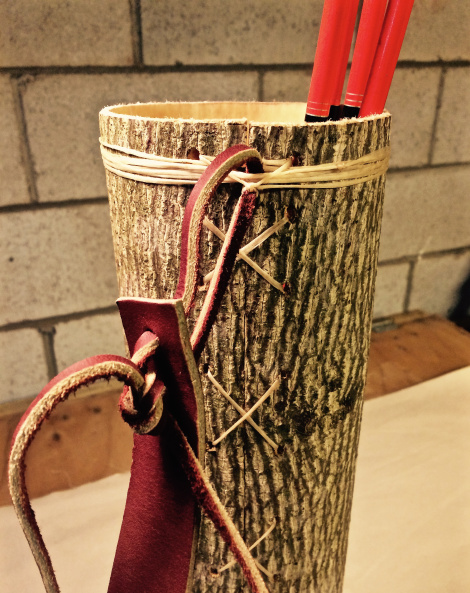
I did the same thing at the opposite end and attached a piece of scrap leather (25 inches long) to the thongs. The thongs allow me to adjust the length of my quiver much like the sling I made for my hands-free ax sheath.
You may also want to add a strip of fur on the inside rim to prevent arrows from banging against the bark quiver when walking the woods. It also adds a great primitive touch to your functional work of art!
This Tulip Tree will provide enough bark for more containers and other resources of self-reliance. Here’s a bonus berry basket made from another 22 inch section of bark…
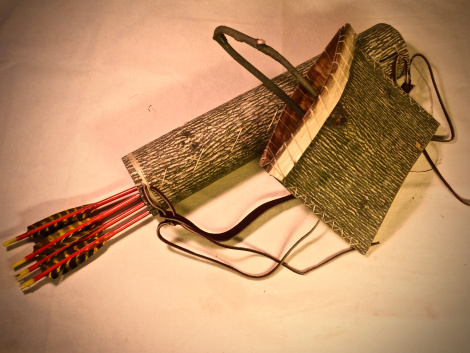
If you find value in our blog, Dirt Road Girl and I would appreciate your vote on Top Prepper Sites! You can vote daily by clicking here or on the image below. Check out all the other value-adding sites while you’re there…
Thanks for Sharing the Stuff!
Copyright: Content on this site (unless the work of a third-party) may be shared freely in digital form, in part or whole, for non-commercial use with a link back to this site crediting the author. All links in articles must remain intact as originally posted in order to be republished. If you are interested a third-party article, please contact the author directly for republishing information.
Keep Doing the Stuff of Self-Reliance,
by Todd Walker

